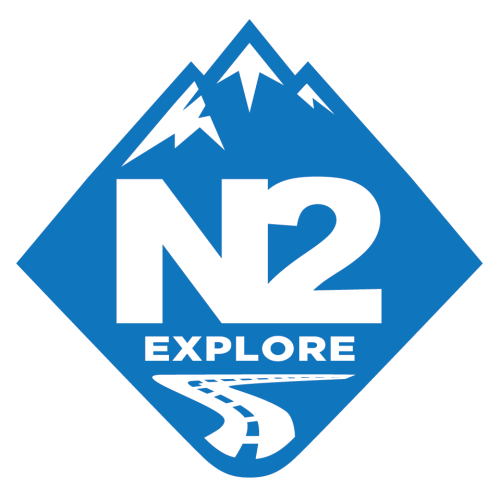Phoenix is heating up and planning to stay that way for the next many months. The Arizona heat in the summer months can really put a damper on local adventurers. In the cooler months, the city’s surrounding mountains offer endless opportunities to hike, bike, rock climb, and explore but once the spring bloom is over, Phoenicians start to look farther than our own back yard to get outdoors.
Luckily, there are still many places in Arizona that aren’t yet reaching the 90s. So, if you want to explore the desert, you haven’t missed your shot! Just look to higher elevations north and south of the city. N2 Explore makes it easy to reach all these destinations from our local hub in Phoenix. Check out our rental vans.
Sedona, 4350 feet – 2-hour drive from Phoenix
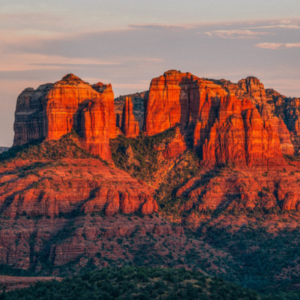 Sedona is well-known for its epic red rock backdrop and endless adventure options. Expansive trail networks are perfect for hiking, trail running, and mountain biking. Hot air balloon rides float over the desert every morning, offering stunning views of the town. Tons of delicious restaurants, shops, and art galleries line the streets of uptown. OHV rentals and jeep tours give even more options to get out into the natural environment. The north end of town at the foot of Oak Creek Canyon, at Slide Rock State Park, is a beautiful place to take a dip when temperatures are at their highest. We could spend the whole summer exploring and still not see it all.
Sedona is well-known for its epic red rock backdrop and endless adventure options. Expansive trail networks are perfect for hiking, trail running, and mountain biking. Hot air balloon rides float over the desert every morning, offering stunning views of the town. Tons of delicious restaurants, shops, and art galleries line the streets of uptown. OHV rentals and jeep tours give even more options to get out into the natural environment. The north end of town at the foot of Oak Creek Canyon, at Slide Rock State Park, is a beautiful place to take a dip when temperatures are at their highest. We could spend the whole summer exploring and still not see it all.
Flagstaff, 6910 feet – 2.25-hour drive from Phoenix
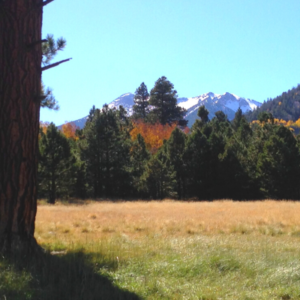 Flagstaff is a cute college town nestled at the base of the spectacular San Francisco peaks. The pine forest will make you forget you’re even in Arizona. In the winter, this is where Arizonans go for snow – there’s even a small ski resort. In the summer, it’s an outdoor adventure mecca. Humphrey’s Peak is the highest point in the state of Arizona at well over 12000 feet. The summit is a challenging 10-mile out-and-back, not to be taken lightly, but is just one of dozens of trails in the San Francisco Peaks. Like Sedona, mountain biking, hiking, and running are all popular pursuits. Just be careful—these activities at elevation can be more exhausting than usual so plan ahead! The vibrant downtown bustles in the summer months as tourists travel through on their way to Grand Canyon. And you’ll want to check out the Lowell Observatory as ASU—the perfect way to get up close and personal with the night sky before heading back to camp.
Flagstaff is a cute college town nestled at the base of the spectacular San Francisco peaks. The pine forest will make you forget you’re even in Arizona. In the winter, this is where Arizonans go for snow – there’s even a small ski resort. In the summer, it’s an outdoor adventure mecca. Humphrey’s Peak is the highest point in the state of Arizona at well over 12000 feet. The summit is a challenging 10-mile out-and-back, not to be taken lightly, but is just one of dozens of trails in the San Francisco Peaks. Like Sedona, mountain biking, hiking, and running are all popular pursuits. Just be careful—these activities at elevation can be more exhausting than usual so plan ahead! The vibrant downtown bustles in the summer months as tourists travel through on their way to Grand Canyon. And you’ll want to check out the Lowell Observatory as ASU—the perfect way to get up close and personal with the night sky before heading back to camp.
Grand Canyon South Rim, 7000 feet – 3.5-hour drive from Phoenix
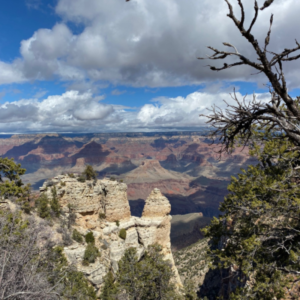 Most people don’t realize that the Grand Canyon is a high elevation destination, but it only makes sense that to be a mile deep, the rim must be at least a mile high! At around 7000 feet, the South Rim offers some escape from the summer heat, but be prepared for the summer crowds, as it was the fourth most visited National Park in recent years. It is also important to keep in mind if you are planning to hike or even ride the mule train down into the canyon—the temperatures rise as you descend. It can be up to 30 degrees cooler on the South Rim than at the Colorado River 4500 feet below on any given day.
Most people don’t realize that the Grand Canyon is a high elevation destination, but it only makes sense that to be a mile deep, the rim must be at least a mile high! At around 7000 feet, the South Rim offers some escape from the summer heat, but be prepared for the summer crowds, as it was the fourth most visited National Park in recent years. It is also important to keep in mind if you are planning to hike or even ride the mule train down into the canyon—the temperatures rise as you descend. It can be up to 30 degrees cooler on the South Rim than at the Colorado River 4500 feet below on any given day.
Grand Canyon North Rim, 8000 feet – 5.5-hour drive from Phoenix
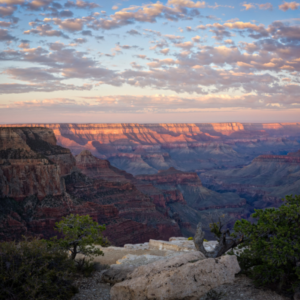 The North Rim of the Grand Canyon is one of Arizona’s best kept secrets. Because of the added drive time and comparative remoteness, it is much less visited than the south rim. It is only open from May to October because roads are not maintained over the winter months and snow can make them impassible—so summer is the only time to visit. North Rim in July is all shady pine forest, seas of purple lupine, and peaceful breezy days. There are, of course, plenty of trails, a small lodge, and the wide expanse of high desert as far as the eye can see. You would hardly know that the bustling South Rim was only 10 miles away as the crow flies, because of the arduous trek to cross that distance, by foot or car.
The North Rim of the Grand Canyon is one of Arizona’s best kept secrets. Because of the added drive time and comparative remoteness, it is much less visited than the south rim. It is only open from May to October because roads are not maintained over the winter months and snow can make them impassible—so summer is the only time to visit. North Rim in July is all shady pine forest, seas of purple lupine, and peaceful breezy days. There are, of course, plenty of trails, a small lodge, and the wide expanse of high desert as far as the eye can see. You would hardly know that the bustling South Rim was only 10 miles away as the crow flies, because of the arduous trek to cross that distance, by foot or car.
Bisbee, 5538 feet – 3.5-hour drive from Phoenix
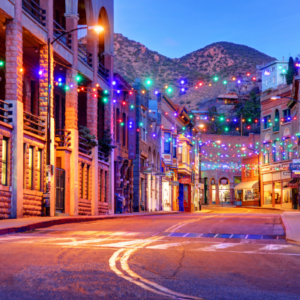 Generally, we think of heading north from Phoenix to escape the heat, but there are actually some great high-elevation locales to the south that you should also check out. Bisbee is a historic mining town nestled in the Mule Mountains just north of the Mexican border. Though the mine is no longer in operation, it offers daily tours and lends a specific mountain town energy to the whole area. With funky restaurants and local street art, you can’t miss the unique style of Bisbee. And it’s only a short drive to Patagonia Lake and Kartchner Caverns—two of Arizona’s 30+ state parks.
Generally, we think of heading north from Phoenix to escape the heat, but there are actually some great high-elevation locales to the south that you should also check out. Bisbee is a historic mining town nestled in the Mule Mountains just north of the Mexican border. Though the mine is no longer in operation, it offers daily tours and lends a specific mountain town energy to the whole area. With funky restaurants and local street art, you can’t miss the unique style of Bisbee. And it’s only a short drive to Patagonia Lake and Kartchner Caverns—two of Arizona’s 30+ state parks.
For a 3-day trip to Southern, Arizona including a stop in Bisbee—check out our full trip plan!
Tips to stay cool in a van:
Even in cooler locations in Arizona, it can still reach the 90s during the day. So here are some strategies to keep it cool in the desert.
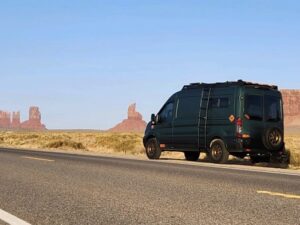 Park in the shade: If there is shady parking available, always opt for that. Direct sunlight will heat up the inside of the van much faster than the surrounding air temperatures. We’ve thoroughly insulated our N2 vans to slow the penetration of outside temperatures as best as possible. Also make sure to put up the reflective window covers, as windows are a completely uninsulated area. When parking in the shade, you’ll want to put out the portable solar panel in the direct sunlight away from the van, so you don’t miss out on all that midday energy charging!
Park in the shade: If there is shady parking available, always opt for that. Direct sunlight will heat up the inside of the van much faster than the surrounding air temperatures. We’ve thoroughly insulated our N2 vans to slow the penetration of outside temperatures as best as possible. Also make sure to put up the reflective window covers, as windows are a completely uninsulated area. When parking in the shade, you’ll want to put out the portable solar panel in the direct sunlight away from the van, so you don’t miss out on all that midday energy charging!- Run the fan: open the vent fan and turn that baby on. Make sure to crack at least one other window or door to allow air to circulate from outside.
- Open the side and back doors: if you’re going to be hanging out inside the van during the day, open the doors wide and let as much air flow as possible. We’ve provided handy bug nets on the side and back doors so you can enjoy the best parts of nature without the creepy crawly ones.
- Put up the Moon Shade: If you can’t park the van in the shade, at least you can park yourself in the shade! The Moon Shade is easy to set up in about 10 minutes and brings your own personal shade to even the most exposed desert landscape.
Guest writer: Christine Reed, @ruggedoutdoorswoman.
